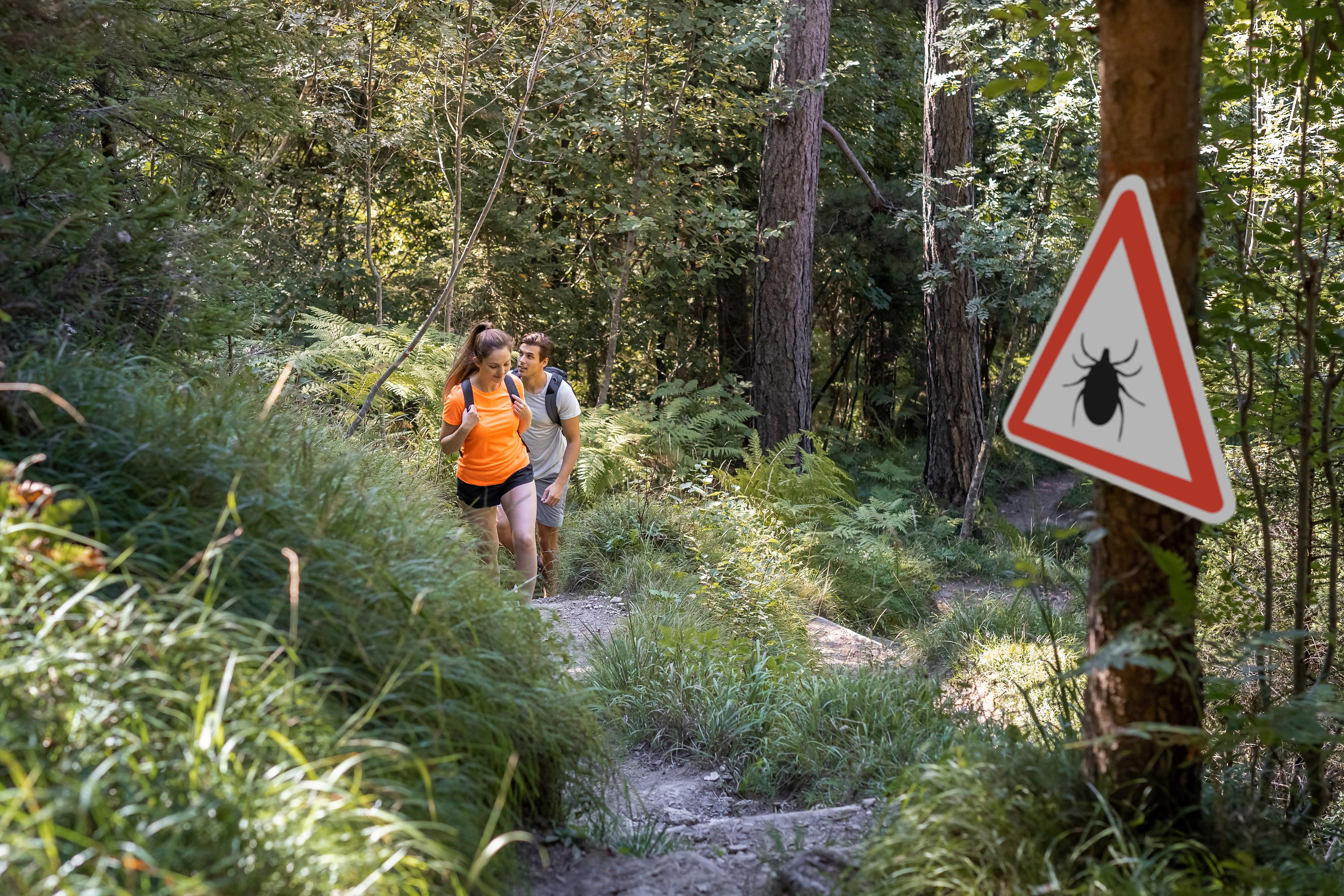Public Health France points to an increase in new diagnosed cases of Lyme disease over the last twenty years. Can we attribute this increase, even if only in part, to climate change and changes in our environment? “There is no clear and simple answer because the system is particularly complex and involves many interacting actors,” explains Olivier Plantard, research director at INRAE, specialist in eco-epidemiology and animal health. In Europe, it is the Ixodes ricinus tick (in the form of larva, nymph or adult) which serves as a vector for this disease, by carrying a pathogenic bacteria of the Borrelia genus. By biting a host, an infected tick can then transmit the bacteria.
The optimal temperature conditions for the development of a tick, whose life cycle extends over two to three years, are between 15 and 25°C. Outside of this interval, the animal's development speed is slowed down, ticks can even enter a period of slowed life (diapause). Due to climate change, “diapause periods could be shorter in the future,” estimates infectious disease specialist Solene Patrat-Delon. Warming also allows ticks to spread into areas that were previously too cold for them. “Scientific articles have clearly shown over the past 20 to 30 years a rise towards the north of Scandinavia of the Ixodes ricinus tick as well as at higher altitudes in the mountains” explains Olivier Plantard.
However, temperature is far from being the only parameter that modifies the development of the tick. It is influenced by humidity (they prefer very humid air) but also depends closely on other living organisms. And sometimes in a surprising way... Researchers have, for example, noted a close relationship with... the quantity of acorns! In fact, the tick likes to attach itself to rodents which consume acorns. The more acorns there are, the more rodents there will be and the more the tick will be able to reproduce and transmit the bacteria. However, climate change modifies the seasonality of plants, which in turn modifies the behavior and distribution of animals that feed on plants. Variation in animal populations thus modifies tick populations, which modulates the dynamics of the disease. Everything is connected. This is also the basis of the “One health” concept, which considers that human, animal and plant health should not be dissociated from each other.
And it can get even more complex. “The transmission competence is different depending on the species bitten by the tick,” reports infectious disease specialist Solene Patrat-Delon. “Deer have an efficient immune system which prevents the multiplication of the bacteria causing Lyme borreliosis. » Deer therefore participate in a “dilution effect”. Their presence within ecosystems helps reduce the probability that a tick will be contaminated by the bacteria, unlike micromammals such as voles.
Building an epidemiological model integrating the three categories of actors (bacteria, ticks and hosts) with their diversity and variability is particularly complex. And understanding how it evolves with warming and changes in the environment is even more complicated. According to researcher Olivier Plantard, the fight and prevention against Lyme disease would benefit from a rapprochement between epidemiologists, veterinarians and ecologists. “The disease is not subject to mandatory reporting by doctors, so we have deprived ourselves of a lot of information that would be particularly useful for better understanding the environmental factors favoring the risk of contracting the disease. »

 Who was Dror Or, the Israeli father who died as a hostage in the hands of Hamas?
Who was Dror Or, the Israeli father who died as a hostage in the hands of Hamas? “Pay in cash”: at his trial, Donald Trump faced with an embarrassing recording
“Pay in cash”: at his trial, Donald Trump faced with an embarrassing recording Italy: a grandmother accidentally serves a bottle filled with wine to a baby, he has an alcoholic coma
Italy: a grandmother accidentally serves a bottle filled with wine to a baby, he has an alcoholic coma The mysterious skeletons of Hermann Göring's villa
The mysterious skeletons of Hermann Göring's villa Children born thanks to PMA do not have more cancers than others
Children born thanks to PMA do not have more cancers than others Breast cancer: less than one in two French women follow screening recommendations
Breast cancer: less than one in two French women follow screening recommendations “Dazzling” symptoms, 5,000 deaths per year, non-existent vaccine... What is Lassa fever, a case of which has been identified in Île-de-France?
“Dazzling” symptoms, 5,000 deaths per year, non-existent vaccine... What is Lassa fever, a case of which has been identified in Île-de-France? Sánchez cancels his agenda and considers resigning: "I need to stop and reflect"
Sánchez cancels his agenda and considers resigning: "I need to stop and reflect" Health carpooling, this source of savings which arouses the ire of patients and taxis
Health carpooling, this source of savings which arouses the ire of patients and taxis Tesla Model 3, MG4 and Dacia Spring.... With the end of the ecological bonus, these electric cars produced in China are seeing their sales fall
Tesla Model 3, MG4 and Dacia Spring.... With the end of the ecological bonus, these electric cars produced in China are seeing their sales fall For the 2024 Olympics, Airbnb commits to fighting prostitution in its accommodation
For the 2024 Olympics, Airbnb commits to fighting prostitution in its accommodation “Shrinkflation”: supermarkets obliged to alert their customers from July 1
“Shrinkflation”: supermarkets obliged to alert their customers from July 1 The electro of Justice and the echoes of Portishead
The electro of Justice and the echoes of Portishead 1924 Olympic Games: according to his daughter, the hero of Chariots of Fire was “not a bigot”
1924 Olympic Games: according to his daughter, the hero of Chariots of Fire was “not a bigot” The “German Brothel” in Yvelines: an uncertain future for the ruined residence
The “German Brothel” in Yvelines: an uncertain future for the ruined residence The eye of the INA: when Paul Auster visited Bernard Pivot
The eye of the INA: when Paul Auster visited Bernard Pivot Omoda 7, another Chinese car that could be manufactured in Spain
Omoda 7, another Chinese car that could be manufactured in Spain BYD chooses CA Auto Bank as financial partner in Spain
BYD chooses CA Auto Bank as financial partner in Spain Tesla and Baidu sign key agreement to boost development of autonomous driving
Tesla and Baidu sign key agreement to boost development of autonomous driving Skoda Kodiaq 2024: a 'beast' plug-in hybrid SUV
Skoda Kodiaq 2024: a 'beast' plug-in hybrid SUV The home mortgage firm rises 3.8% in February and the average interest moderates to 3.33%
The home mortgage firm rises 3.8% in February and the average interest moderates to 3.33% This is how housing prices have changed in Spain in the last decade
This is how housing prices have changed in Spain in the last decade The home mortgage firm drops 10% in January and interest soars to 3.46%
The home mortgage firm drops 10% in January and interest soars to 3.46% The jewel of the Rocío de Nagüeles urbanization: a dream villa in Marbella
The jewel of the Rocío de Nagüeles urbanization: a dream villa in Marbella Facing Jordan Bardella, the popularity match turns to Gabriel Attal’s advantage
Facing Jordan Bardella, the popularity match turns to Gabriel Attal’s advantage Europeans: a senior official on the National Rally list
Europeans: a senior official on the National Rally list Blockade of Sciences Po: the right denounces a “drift”, the government charges the rebels
Blockade of Sciences Po: the right denounces a “drift”, the government charges the rebels Even on a mission for NATO, the Charles-de-Gaulle remains under French control, Lecornu responds to Mélenchon
Even on a mission for NATO, the Charles-de-Gaulle remains under French control, Lecornu responds to Mélenchon These French cities that will boycott the World Cup in Qatar
These French cities that will boycott the World Cup in Qatar Monaco - Clermont: Minamino cornerstone, Fofana essential, the Clermont defense overwhelmed... The tops and the flops
Monaco - Clermont: Minamino cornerstone, Fofana essential, the Clermont defense overwhelmed... The tops and the flops Gymnastics: two gold medals for the Italian Manila Esposito during the European Championships
Gymnastics: two gold medals for the Italian Manila Esposito during the European Championships Champions Cup: in pain, Leinster beats Northampton and qualifies for the final
Champions Cup: in pain, Leinster beats Northampton and qualifies for the final Liga: Real Madrid crowned champion of Spain after FC Barcelona's defeat in Girona
Liga: Real Madrid crowned champion of Spain after FC Barcelona's defeat in Girona


















